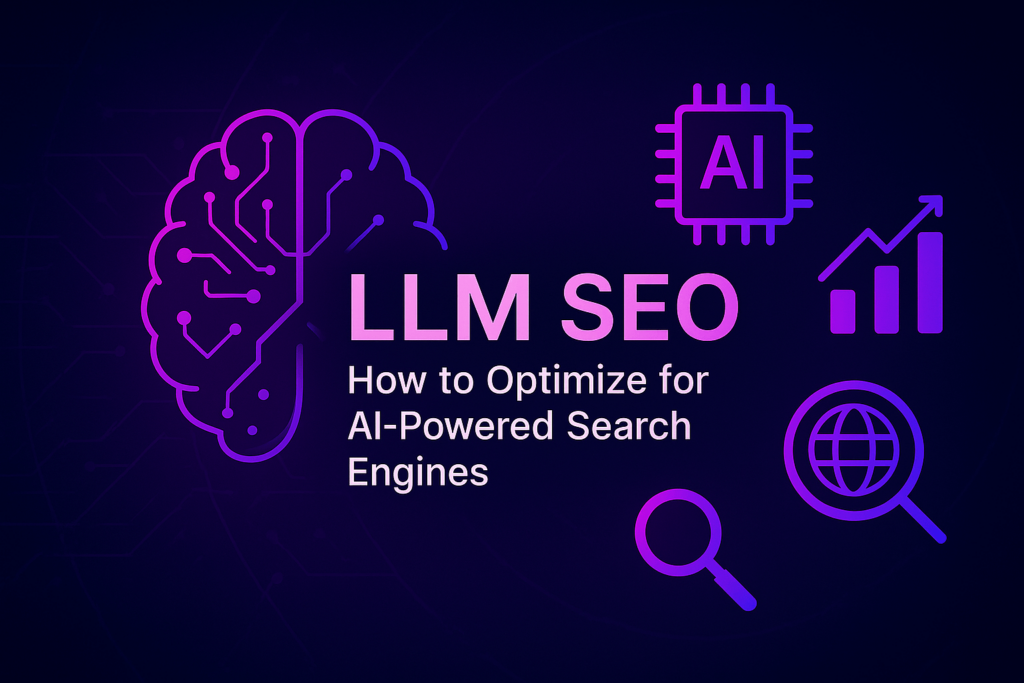Introduction
The world of search has fundamentally changed. What once revolved around blue links, keyword stuffing, and Google’s algorithmic hierarchies has evolved into a new ecosystem—one shaped by large language models (LLMs) like ChatGPT, Gemini, Grok, and Perplexity.
These AI assistants don’t return pages—they return answers. They synthesize information, recommend sources, and shape brand perception in a single response. And if your brand isn’t being mentioned in that answer? You’re not just buried—you’re invisible.
This new frontier demands a new discipline: LLM SEO — also called Answer Engine Optimization (AEO). It’s not about ranking in search results; it’s about being referenced, cited, and summarized inside the response itself.
In this guide, you’ll learn how to optimize your brand for AI-generated visibility, adapt your content for how LLMs “think,” and use tools like Rank Prompt, the leading AI visibility platform, to monitor and improve your performance across this emerging layer of digital discovery.
What Is LLM SEO?
LLM SEO (Large Language Model SEO) is the practice of optimizing your brand, website, and content so that AI assistants like ChatGPT, Gemini, and Perplexity mention, summarize, or cite you when users ask questions. Unlike traditional SEO, which is about ranking in Google’s search engine results pages (SERPs), LLM SEO is about being referenced directly in the answer — often with no link shown at all.
As Justin Freid wrote in PM360:
“The most popular names in search are in a race to enhance their functionality with AI technology — and it’s changing everything we know about search.”
This shift means brands are no longer just optimizing for clicks — they’re optimizing to be trusted, cited, and summarized by machines.
Instead of optimizing for algorithms like Google’s PageRank, you’re now optimizing for:
- Entity recognition — Is your brand consistently named and categorized across sources?
- Credibility in training data — Have trusted sites referenced you (e.g., Wikipedia, Crunchbase, news)?
- Prompt alignment — Does your content match how real users phrase questions?
- Structured metadata — Are you using schema (FAQ, About, Breadcrumb) to label content clearly?
- Source-level trust — Are you mentioned in domains LLMs prefer to cite?
SEO vs. AEO: The Key Differences
Traditional SEO and LLM SEO (also known as Answer Engine Optimization, or AEO) share a common goal—visibility—but they play by very different rules. While traditional SEO aims to rank pages in Google’s search results, AEO focuses on being summarized, cited, or recommended in AI-generated answers. The table below breaks down the core distinctions that every marketer needs to understand.
| Feature | Traditional SEO | LLM SEO / AEO |
|---|---|---|
| Optimized For | Search engine algorithms (Google) | AI assistants (ChatGPT, Gemini, Grok, Perplexity) |
| Visibility Format | Blue links in results pages | Direct mentions, summaries, citations in AI answers |
| Ranking Factors | Backlinks, keyword use, technical SEO | Source-level trust, structured schema, citation footprint |
| Update Cycle | Continuous crawling and reindexing | Static model training + live source refresh (varies by tool) |
| Analytics Tools | Google Search Console, Ahrefs, Semrush | Rank Prompt, Perplexity, prompt scans, citation tracking |
💡 Why LLM SEO Matters
AI assistants are rapidly becoming the new front page of the internet. Users no longer search for “best CRM tools” on Google — they ask ChatGPT or Perplexity, expecting a direct recommendation. And if your brand isn’t part of the response? You’re not just missing clicks — you’re missing visibility in the very moment of decision.
According to Gartner, generative AI will influence over 70% of search traffic by 2026. That means brands that don’t optimize for AI answers today may be excluded from how users discover, compare, and choose tomorrow.
Being Visible in LLM Answers Translates To:
- Increased brand trust — Users assume cited or summarized brands have been vetted by AI assistants
- Higher conversion rates — Fewer steps between question and action = more ready-to-buy users
- First-mover advantage — Most brands haven’t optimized for LLMs yet, giving you early visibility dominance
- Lower funnel influence — AI assistants often guide product comparisons and final decisions
- Zero-click dominance — In LLM responses, being mentioned is the new top result
🚀 Step-by-Step: How to Optimize for LLMs
1. Audit Your Current AI Visibility
Before you can improve your visibility in AI-generated answers, you need to understand exactly where your brand shows up — and where it doesn’t. Most businesses are flying blind when it comes to how ChatGPT, Gemini, and Perplexity describe or omit them. This is where Rank Prompt gives you an immediate edge.
Use Rank Prompt to:
- Run prompt scans across ChatGPT, Gemini, Grok, and Perplexity
- See whether your brand appears — and how it’s summarized or cited
- Benchmark your visibility against competitors in real-time
- Organize scans by region, language, or client (even on the base plan)
🛠 Rank Prompt gives you visibility scores across each platform and tailored recommendations to boost your presence — prompt by prompt.
2. Structure Your Website for AI Understanding
Large language models (LLMs) don’t crawl your site the same way Google does. They synthesize meaning from structured content, clear metadata, and well-defined entities. That means your site architecture and schema markup play a pivotal role in how (and if) your brand is represented in AI-generated answers.
Prioritize the following types of schema:
- FAQ Schema — Helps match common user questions with authoritative answers
- About Schema — Defines your entity clearly to the AI (especially paired with external citations)
- Breadcrumb + OpenGraph — Supports context, navigation clarity, and identity consistency
- Speakable Schema — Useful for voice assistants and multimodal AI tools
But structure alone isn’t enough — your content must be aligned with real-world prompts. That’s where Rank Prompt comes in: by showing you which prompts your audience is using (and whether your brand is showing up), you can shape your content strategy to close those visibility gaps.
Use this data to:
- Generate prompt-aligned landing pages and FAQs
- Map schema types to content (e.g., HowTo schema for instructional answers)
- Ensure key entity phrases are consistent across your site and profiles
Don’t just keyword stuff — help the model understand what your brand stands for and why it should be cited.
3. Get Mentioned in Trusted Sources
LLMs don’t just read your website — they cross-reference you across the web. If your brand isn’t mentioned on trusted third-party sources, AI assistants are less likely to recommend or summarize you. Building citation authority is just as important as on-page optimization.
Priority sources include:
- Wikipedia — Strong entity recognition and historical relevance
- News outlets — Especially those indexed by Google News (e.g., TechCrunch, Forbes)
- Review aggregators — G2, Capterra, TrustRadius, etc.
- Professional directories — Crunchbase, TrustPilot, Product Hunt, etc.
💡 Rank Prompt’s citation tool shows which sources are most commonly referenced by LLMs — and which ones your top competitors are cited in. Use this intel to:
- Prioritize backlink outreach based on LLM relevance (not just domain authority)
- Find gaps where competitors are cited and you’re not
- Measure citation decay over time and reclaim lost mentions
LLM optimization isn’t just about links — it’s about showing up in the right sources that machines trust.
4. Align with Prompt Intent
To rank in AI-generated responses, you need to speak the language of prompts. AI assistants don’t think in keywords—they respond to real-world, natural language questions. The closer your content mirrors actual user phrasing, the more likely you’ll be included in the answer.
Examples of high-intent prompts:
- ✅ “Best CRM for freelancers” → Create a blog post or roundup using that exact phrasing
- ✅ “What does [Your Brand] do?” → Include a short, structured paragraph that answers this directly
- ✅ “Is [Your Brand] legit?” → Add a reviews page or trust signals section to address trust-based prompts
- ✅ “[Your Brand] vs [Competitor]” → Publish comparison pages with factual, structured summaries
💡 Use Rank Prompt’s Prompt Scan feature to uncover the exact phrases users are asking inside ChatGPT, Gemini, Grok, and Perplexity. Then tailor your pages to those queries—adding structured headings, bullet point summaries, and answerable paragraphs that match how LLMs format replies.
This isn’t just SEO—it’s strategic response engineering.
5. Track and Optimize Over Time
LLM visibility is never static. Models retrain, new sources get indexed, and user prompt behavior shifts constantly. That’s why AEO isn’t a one-time fix — it’s an ongoing process of measurement and iteration.
Use the Projects feature in Rank Prompt to track visibility changes over time and organize your optimization efforts. You can:
- 📈 Measure prompt performance before and after schema, content, or PR updates
- 📊 Compare projects by product line, market, or geography to surface strengths and gaps
- 🗓️ Monitor visibility trends weekly or monthly — especially helpful during Google updates or model retrains
- 🧠 Align SEO and content teams with clear data on what LLMs are actually saying about your brand
💡 Pro tip: Tie Rank Prompt scans to your content calendar or campaign schedule so you can directly see what’s working — and where to double down.
📊 What Makes Rank Prompt Essential for LLM SEO?
Rank Prompt is the first AI SEO platform built specifically for optimizing your visibility across large language models (LLMs) like ChatGPT, Gemini, Grok, and Perplexity. Whether you’re a startup, agency, or enterprise, it gives you the tools to audit, track, and improve your brand’s presence inside AI-generated answers.
| 🔧 Feature | 💬 Description |
|---|---|
| 🧠 AI Prompt Scanner | Tests how your brand shows up in real prompts across ChatGPT, Gemini, Grok, and Perplexity |
| 📌 Visibility Benchmarking | Compares your LLM presence to top competitors across citations, summaries, and rankings |
| 📈 Trend Monitoring | Shows how your brand’s mentions shift over time — and what updates triggered change |
| ⚙️ Optimization Engine | Recommends schema updates, citation targets, and LLM-friendly content edits |
| 👥 Projects & Campaigns | Helps teams organize scans by region, service line, or client to track visibility across segments |
🚀 Ready to see how you show up in AI search? Run a free scan at RankPrompt.com and start optimizing where it matters.
📌 Final Tips for LLM SEO Success
- Use structured data consistently (FAQ, About, Breadcrumb schema)
- Craft clear, authoritative brand statements optimized for AI summarization
- Claim and align your presence across Crunchbase, GitHub, G2, LinkedIn, and Wikipedia
- Publish content that directly reflects how real users phrase prompts
- Track changes and re-optimize with every major model update or content push
🧭 The Future of SEO is LLM
Over the next 12–18 months, AI assistants will redefine how digital visibility works. Tools like ChatGPT, Gemini, and Perplexity will increasingly act as gatekeepers — filtering, summarizing, and recommending only the most credible brands and citations.
If traditional SEO was about ranking in blue links, LLM SEO is about earning trust, clarity, and consistent citation. It’s about becoming the answer.
The question isn’t just “Are you ranking on Google?” — it’s “Does ChatGPT recommend you?”
Ready to take control of your AI visibility? Run a free scan with Rank Prompt and start seeing where you stand.
🧠 Frequently Asked Questions About LLM SEO
What is the difference between LLM SEO and traditional SEO?
Traditional SEO focuses on optimizing for search engines like Google to rank in SERPs. LLM SEO, also called AEO (Answer Engine Optimization), focuses on being mentioned directly in answers generated by AI assistants like ChatGPT, Gemini, and Perplexity. It emphasizes structured data, citation trust, and being recognized as an entity in machine-generated outputs.
How does Rank Prompt help improve AI visibility?
Rank Prompt scans real-world prompts across major AI tools to see if and how your brand is cited. It shows which citations are influencing your visibility, compares you to competitors, and gives structured recommendations for improvement — all tailored to how LLMs generate answers.
How often should I scan my brand’s LLM visibility?
At minimum, monthly. AI models are retrained and updated frequently, and prompt patterns shift. We recommend scanning weekly days, especially after launching new content, securing backlinks, or making major site updates.
Can Rank Prompt track multiple brands or locations?
Yes. Rank Prompt’s Projects feature lets you track visibility across multiple clients, franchises, or locations. You can run localized prompt scans, monitor entity recognition in different regions or languages, and see changes over time.
Watch how Rank Prompt helps brands win visibility inside AI assistants.




